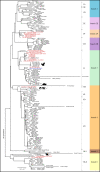Multi-omic detection of Mycobacterium leprae in archaeological human dental calculus
- PMID: 33012227
- PMCID: PMC7702802
- DOI: 10.1098/rstb.2019.0584
Multi-omic detection of Mycobacterium leprae in archaeological human dental calculus
Abstract
Mineralized dental plaque (calculus) has proven to be an excellent source of ancient biomolecules. Here we present a Mycobacterium leprae genome (6.6-fold), the causative agent of leprosy, recovered via shotgun sequencing of sixteenth-century human dental calculus from an individual from Trondheim, Norway. When phylogenetically placed, this genome falls in branch 3I among the diversity of other contemporary ancient strains from Northern Europe. Moreover, ancient mycobacterial peptides were retrieved via mass spectrometry-based proteomics, further validating the presence of the pathogen. Mycobacterium leprae can readily be detected in the oral cavity and associated mucosal membranes, which likely contributed to it being incorporated into this individual's dental calculus. This individual showed some possible, but not definitive, evidence of skeletal lesions associated with early-stage leprosy. This study is the first known example of successful multi-omics retrieval of M. leprae from archaeological dental calculus. Furthermore, we offer new insights into dental calculus as an alternative sample source to bones or teeth for detecting and molecularly characterizing M. leprae in individuals from the archaeological record. This article is part of the theme issue 'Insights into health and disease from ancient biomolecules'.
Keywords: Mycobacterium leprae; ancient DNA; dental calculus; leprosy; palaeoproteomics.
Conflict of interest statement
We have no competing interests.
Figures


Similar articles
-
Mycobacterium leprae genomes from a British medieval leprosy hospital: towards understanding an ancient epidemic.BMC Genomics. 2014 Apr 8;15:270. doi: 10.1186/1471-2164-15-270. BMC Genomics. 2014. PMID: 24708363 Free PMC article.
-
Ancient Mycobacterium leprae genome reveals medieval English red squirrels as animal leprosy host.Curr Biol. 2024 May 20;34(10):2221-2230.e8. doi: 10.1016/j.cub.2024.04.006. Epub 2024 May 3. Curr Biol. 2024. PMID: 38703773
-
Functional diversity of microbial ecologies estimated from ancient human coprolites and dental calculus.Philos Trans R Soc Lond B Biol Sci. 2020 Nov 23;375(1812):20190586. doi: 10.1098/rstb.2019.0586. Epub 2020 Oct 5. Philos Trans R Soc Lond B Biol Sci. 2020. PMID: 33012230 Free PMC article.
-
Tuberculosis and leprosy associated with historical human population movements in Europe and beyond - an overview based on mycobacterial ancient DNA.Ann Hum Biol. 2019 Mar;46(2):120-128. doi: 10.1080/03014460.2019.1624822. Epub 2019 Jun 20. Ann Hum Biol. 2019. PMID: 31137975 Review.
-
Molecular studies on ancient M. tuberculosis and M. leprae: methods of pathogen and host DNA analysis.Eur J Clin Microbiol Infect Dis. 2015 Sep;34(9):1733-49. doi: 10.1007/s10096-015-2427-5. Epub 2015 Jul 26. Eur J Clin Microbiol Infect Dis. 2015. PMID: 26210385 Free PMC article. Review.
Cited by
-
Paleoproteomics.Chem Rev. 2022 Aug 24;122(16):13401-13446. doi: 10.1021/acs.chemrev.1c00703. Epub 2022 Jul 15. Chem Rev. 2022. PMID: 35839101 Free PMC article. Review.
-
First archaeological evidence for ginger consumption as a potential medicinal ingredient in a late medieval leprosarium at St Leonard, Peterborough, England.Sci Rep. 2024 Jan 30;14(1):2452. doi: 10.1038/s41598-024-52422-8. Sci Rep. 2024. PMID: 38291078 Free PMC article.
-
Leprosy in skeletons from archaeological sites: A systematic review.PLoS Negl Trop Dis. 2025 Aug 19;19(8):e0013374. doi: 10.1371/journal.pntd.0013374. eCollection 2025 Aug. PLoS Negl Trop Dis. 2025. PMID: 40828789 Free PMC article.
-
Paleomicrobiology: Tracking the past microbial life from single species to entire microbial communities.Microb Biotechnol. 2024 Jan;17(1):e14390. doi: 10.1111/1751-7915.14390. Epub 2024 Jan 16. Microb Biotechnol. 2024. PMID: 38227345 Free PMC article. Review.
-
Metagenomic and paleopathological analyses of a historic documented collection explore ancient dental calculus as a diagnostic tool.Sci Rep. 2024 Jun 26;14(1):14720. doi: 10.1038/s41598-024-64818-7. Sci Rep. 2024. PMID: 38926415 Free PMC article.
References
-
- De La Fuente CP, Flores SV, Moraga ML. 2012. Human bacterial DNA from dental calculus: a new source of genetic material. Am. J. Phys. Anthropol. 147, 127.
Publication types
MeSH terms
Substances
Associated data
LinkOut - more resources
Full Text Sources
Medical

